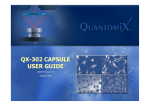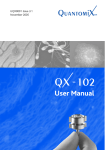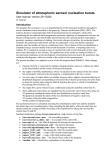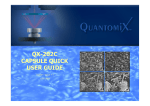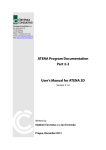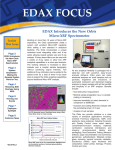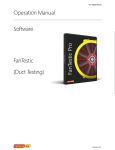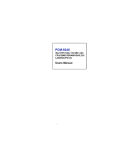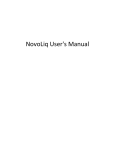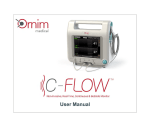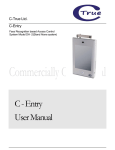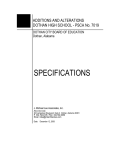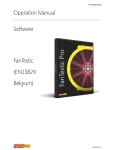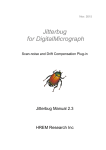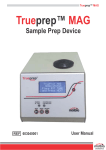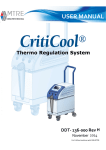Download QX-202C User Manual
Transcript
QX-102 User Manual © QuantomiX Ltd. 2006. All rights reserved. UQX016 Issue 1.1 June 2006 QX-202C User Manual, Issue 1.1 2 This publication is the copyright of QuantomiX Ltd. and contains information that may not be used or reproduced unless agreed in writing. QuantomiX Ltd. reserves the right to alter without notice the specifications, design or supply of any product or service. The information provided in this User Manual is believed to be accurate. It is the user’s responsibility to confirm the technical aspects and the suitability of the technology for any particular application. QuantomiX Ltd., 12 Hamada St., Tamar Science Park, Rehovot POB 4037, Nes-Ziona 70400, Israel Tel: +972-8-946-2244, Fax: +972-8-946-5874 http://www.quantomix.com 3 QX-202C User Manual, Issue 1.1 Table of Contents List of Figures.........................................................................................4 List of Tables ..........................................................................................4 Cited Registered Trademarks .................................................................4 Chapter 1: Safety ..................................................................................5 Chapter 2: Introduction .........................................................................6 2.1 Manual Scope and Contents ............................................................6 2.2 References .......................................................................................6 Chapter 3: Technology and Components ...............................................7 3.1 The QX-202C Capsule ....................................................................7 3.2 The Capsule Plate (MP-12)............................................................10 3. 3 The Applicator .............................................................................11 3.4 Imaging Buffer (IB-64)...................................................................11 3.5 Calibration Capsule (RT-56) ..........................................................12 Chapter 4: Using the QX-202C Capsules .............................................13 4.1 Getting Started ..............................................................................13 4.2 Sample Preparation .......................................................................14 4.3 Inserting Samples into the QX-202C Capsule................................15 4.4 Storing Specimens in the QX-202C Capsule..................................16 Chapter 5: Imaging ..............................................................................17 5.1 Optimal Imaging Conditions .........................................................17 5.2 Recommendations for SEM Imaging with QX-202C Capsules .......19 5.3 Recommendations for EDS Analysis with QX- 202C Capsules ......20 Chapter 6: Appendices .........................................................................23 6.1 Appendix A: Glossary....................................................................23 6.2 Appendix B: Troubleshooting ........................................................24 6.3 Appendix C: Ordering Information ...............................................26 6.4 Appendix D: Legal Notices ............................................................27 QX-202C User Manual, Issue 1.1 List of Figures Figure 1: The QX-202C capsule ............................................................8 Figure 2: Sealed capsule - dimensions ...................................................8 Figure 3: Positioning the QX-202C capsule in the capsule plate............9 Figure 4: Correct positioning of the rubber seal.....................................9 Figure 5: The capsule plate..................................................................10 Figure 6: Opening the QX-202C capsule.............................................13 4 Chapter 1: Safety 5 Chapter 1: Safety ! Please observe the following cautions while using the QuantomiX QX-202C capsules: 1. List of Tables 2. Table 1: Recommendations for SEM Imaging with QX-202C capsules..19 Table 2: Troubleshooting .....................................................................24 3. Cited registered trademarks: 4. Microman® (Gilson® S.A.S.) All trademarks are the properties of their respective owners. Cautions 5. 6. 7. Correct sealing of the capsule is essential for its proper functioning. Capsule sealing is achieved when the wings of the sample dish and the sealing stub are aligned. The top surface of the sample dish must be kept clean in order to ensure proper sealing. The QX-202C sealing stub includes a rubber seal. If the rubber seal accidentally detaches from the sealing stub, it should be re-positioned with the narrow cylinder towards the sample dish. Use powder-free gloves to maintain cleanness of the QX-202C capsules. Powdered gloves should be avoided. Do not place the sample dish or the capsule with the capsule membrane facing down, except in the capsule plate. To prevent rupture, avoid touching the capsule membrane at all stages. Capsule plate must be kept clean. Extreme care must be exercised when using the Microman® M25 supplied with the QX-202C Starter Kit: when applying materials into the capsule, the piston protrudes from the capillary and may potentially damage the capsule membrane. Keep the Microman® tip and piston at a safe distance from the membrane. Chapter 2: Introduction 6 7 Chapter 3: Technology and Components Chapter 2: Introduction Chapter 3: Technology and Components Imaging the micro-dynamics of hydration processes in their early stages has been a long-needed capability. The WETSEM™ technology developed by QuantomiX combines the resolution that characterizes Scanning Electron Microscopes (SEM) with the ability to image water-containing mixtures. The WETSEM™ technology is a proprietary technology developed by QuantomiX Ltd., which enables direct imaging of fully hydrated samples in scanning electron microscopes (SEM). The patented technology is based on a thin, electron-transparent membrane, which seals the sample from the vacuum in the microscope chamber. No freezing or drying of the sample is required, enabling the easy visualization of the dynamics of hydration processes. The technology is based on a thin, electron-transparent membrane that completely isolates the sample from the vacuum in the microscope chamber. Samples are simply placed in the capsule. The capsule is sealed, placed in the SEM and imaged. 2.1 Manual Scope and Contents This manual provides a detailed description of the components required for using the QX-202C capsules. It also provides guidelines for applying samples into the capsules and for SEM imaging. The QX-202C capsules can be used for imaging the dynamics of cement, gypsum or other materials’ hydration processes. The QuantomiX components required for using the technology are listed below. QX-202C capsules Capsule plate (MP-12) Applicator (Microman® M25 and tips) Calibration Capsule and Imaging Buffer 3.1 The QX-202C Capsule 2.2 References 2.2.1 Sites http://www.quantomix.com 2.2.2 Technical Support For technical support please contact your local distributor or [email protected]. The QX-202C capsule shown in Figure 1 is a single use specimen enclosure consisting of a sample dish and a sealing stub. The base of the capsule is the sample dish. It is designed as a small dish in which samples can be placed. The top of the capsule (the sealing stub) is designed to seal the sample. QX-202C User Manual, Issue 1.1 8 Figure 1. The QX-202C capsule Chapter 3: Technology and Components 9 Sample Dish 3.1.2 Use of the QX-202C Capsule Rubber Seal Detailed instructions on the use of the QX-202C capsule are given in Chapter 4. Sealing Stub ! Cautions a. The capsule should be placed in the capsule plate (as seen in Figure 3). Figure 3. Positioning of the QX-202C capsule in the capsule plate 3.1.1 Technical Data Storage The capsules should be stored in a dry, dark environment at room temperature. Shelf life 18 months from specified production date (printed on the box). Application The capsules are intended for single use and are not reusable. They are intended for research purposes only. The QX-202C capsule is suitable for imaging a variety of dynamic reactions. b. Dimensions Sample dish - diameter 3mm Working volume - 6.5-7.5µl Sealed capsule - see Figure 2. In cases where the QX-202C capsule does not fit your SEM stage, inquire about available adaptors. c. Operation Temperature 4° to 40° C 3.14 Figure 4. Position of the rubber seal 16 Rubber Seal 8 QX-202C Stub 18.6 Figure 2. Sealed capsule dimensions Correct sealing of the capsule is essential for its proper functioning. Capsule sealing is achieved when the top surface of the sample dish is clean and the wings of the sample dish and the sealing stub are aligned. Prior to sealing the capsule, ensure the rubber seal is properly positioned in the sealing stub (as seen in Figure 4) d. 12.5 Do not use sharp objects, such as sharp-ended forceps, to hold the rubber seal, in order to prevent damage to the sealing. QX-202C User Manual, Issue 1.1 10 Chapter 3: Technology and Components 11 3.2 The Capsule Plate (MP-12) 3. 3 The Applicator The QX capsule plate is a clear plastic holder for the capsules (see Figure 5). It is designed to hold the capsules during specimen preparation, ensuring the capsule membrane is not damaged, and is also used for storage of capsules. Supplied with the QX-202C Starter Kit is a Gilson® Microman® pipette which is specially designed to accurately displace small quantities of viscous solutions and mixtures. Also supplied is a box of single-use capillaries and pistons which are used in conjunction with the Microman. Figure 5. The Capsule Plate Note Enclosed in the Microman box is a warranty registration card. To ensure registration of warranty, please complete and return this card, by mail or fax, to QuantomiX. For technical details and operating instructions please refer to the enclosed Microman datasheet. Capsule plate, as seen from above Capsule plate and lid 3.2.1 Technical Data Storage Should be stored in a dry, dark environment at room temperature. Shelf Life Three years from specified production date. Application The plates should be used for all stages during which capsules are being handled. Dimensions 85 x 128 x 33 mm Operation Temperature 4° to 40°C 3.4 Imaging Buffer (IB-64) QX Imaging Buffer (Cat. No. IB-64) is a solution required for the imaging of the Calibration Capsule 3.4.1 Technical Data Storage The lyophilized product is stored at room temperature. After reconstitution, store in the dark at 4°C. The reconstituted solution is stable for 1 month at 4°C. Shelf Life See expiry date printed on the bottle. 3.4.2 Use of the Imaging Buffer Use the Microman to add 15 µl of Imaging Buffer to the Calibration Capsule prior to SEM imaging. QX-202C User Manual, Issue 1.1 12 Chapter 4: Using the QX-202C Capsules 13 3.5 Calibration Capsule (RT-56) Chapter 4: Using the QX-202C Capsules The Calibration Capsule (Cat. No. RT-56) is designed for finding the optimal imaging conditions for wet samples with WETSEM™ technology. The following procedures are general and appropriate for many different QX202C applications. It is strongly recommended that new users initially use the Calibration Capsule to find the optimal working conditions of the SEM. Sample imaging with the QX-202C capsule in an SEM differs from standard SEM imaging in some aspects. The factors that affect imaging vary depending on the application and differ from one SEM model to another. The Calibration Capsule contains nanoparticles (40 and 500 nm in size) firmly attached to the capsule membrane. The particles are easily imaged in an SEM and provide a convenient means to calibrate parameters for optimal wet imaging conditions. 4.1 Getting Started The QX-202C capsules and the QX capsule plates (MP-12) are supplied in a sealed container. Open the QX-202C capsule container by peeling back the paper cover. Position the required capsules in the MP-12 capsule plate. Open the positioned capsules by turning the sealing stub counterclockwise (see Figure 6). 3.5.1 Technical Data Figure 6. Opening the QX-202C Capsule Storage Store in dry, dark conditions until opened. After adding Imaging Buffer, store at 4º Shelf Life See expiry date printed on the container. Note 3.5.2 Use of the Calibration Capsule For use and calibration details, refer to the product information sheet accompanying the product and to the supplied "QuickGuide for Imaging with WETSEM™". For ease of application open the capsules prior to sample preparation. Cover the MP-12 capsule plate with the lid to protect the sample dish. Note Prior to using the Calibration Capsule add 15µl of reconstituted Imaging Buffer to the capsule. ! Caution To prevent rupture, never touch the membrane. Keep the sample dish properly positioned in the capsule plate at all times. QX-202C User Manual, Issue 1.1 14 Put aside the sealing stub until the sample is ready for imaging. It is recommended to use the original QX-202C capsule package for storing the sealing stubs. To prepare a sample for SEM imaging, follow the steps described in the following section, or refer to the QX-202C Graphic User Guide supplied with the Starter Kit. Chapter 4: Using the QX-202C Capsules 15 4.2.2 Other Samples Prepare the reaction mixture according to the experimental design and transfer a sample into the sample dish as soon as possible (see section 4.3). 4.3 Inserting Samples into the QX-202C Capsule 4.2 Sample Preparation 4.2.1 Cementitious/Gypsum Samples Place a measured quantity of powder in a dish. Add water according to the ratio required for the experiment. 4.3.1 Placing the sample ! Caution The sample dish contains the membrane that enables viewing of the samples with an SEM. The membrane is very delicate and must not be touched at any time. A damaged membrane is not suitable for use in an SEM. Note Amount of water (ml) = Quantity of cement (gr) X Required ratio (w/c) Mix thoroughly and quickly until mixture is homogeneous. Transfer a sample into the sample dish (see section 4.3) as soon as possible, in order to be able to observe the early stages of the reaction. Set the Microman® to 6.5-7.5µl. Using the Microman, aspirate a sample from the reaction mixture. Carefully dispense the sample into the sample dish. Gently tap the capsule plate, with the filled liquid dishes in it, onto the bench-top. This ensures that the sample homogenously covers the capsule membrane. ! Note Any water:cement ratio can be used with the QX-202C capsule. In very dilute reaction mixtures, large particles may drift away from the membrane. The image in such cases will show mostly the smaller particles. Reaction mixtures which have a paste consistency are most common for WETSEM™ imaging. Caution As the push-button of the Microman is pressed down, the piston will eject the sample out of the capillary and in itself will be slightly ejected. Extreme care must be exercised to prevent the ejected piston from coming close to the capsule membrane. With highly diluted reaction mixtures (with Portland cement, approximately w/c>0.7), it may be difficult to image larger particles. Placing only 1-3µl onto the capsule membrane often solves this difficulty. This method, if used, requires further caution since inserting a small sample places the piston very close to the capsule membrane. QX-202C User Manual, Issue 1.1 16 Chapter 5: Imaging 17 4.3.2 Sealing the capsule Chapter 5: Imaging Once the sample is placed in the sample dish, the capsule may be sealed. While keeping the specimen dish in the capsule plate, place the sealing stub on it. Turn the sealing stub clockwise until the "wings" are aligned. At this point, the capsule is tightly closed and ready for imaging in the SEM (see Chapter 5). To better protect the membrane leave the capsule in the capsule plate until it is placed in the SEM. For further protection, the capsule plate itself should be covered. The factors that affect imaging vary with different applications and different SEMs. This chapter provides guidelines for achieving the best imaging results for wet samples with WETSEM™ technology. 4.4 Storing Specimens in the QX-202C Capsule Samples can be stored in sealed capsules for a limited period. Sample quality will deteriorate over time. The rate of deterioration is a function of the nature of the sample and the storage conditions. The imaging conditions are best optimized using the Calibration Capsule. The Calibration Capsule contains nanoparticles, which are easily visualized in the SEM and provide a convenient means to calibrate the parameters for optimal imaging conditions. The Calibration Capsule is provided with a reference image which enables the user to evaluate the imaging result after optimization. 5.1 Optimal Imaging Conditions Follow the guidelines below to find the optimal imaging conditions. Capsules should be left in the SEM vacuum chamber until the reaction mixture is partially cured and hardened. Subsequently samples can be removed from the vacuum chamber and re-imaged at different intervals through the duration of the reaction. Note Recommendations for SEM parameters are summarized in Table 1. Optimize the conditions first with the Calibration Capsule, and then move on to imaging your sample. Note The sealed capsules can be conveniently stored in the capsule plate. ! Caution The Calibration Capsule and the QX-202C capsule are taller than the average specimen. Lower the stage before placing the capsule in the SEM. 1. Place the closed QX-202C capsule on the microscope stage as a conventional ‘stub’ with the capsule membrane facing up. In case the QX202C capsule does not fit your SEM stage, inquire about available adaptors. QX-202C User Manual, Issue 1.1 18 The QX-202C capsules are suitable for use with high vacuum or low vacuum modes. 3. Ensure sufficient working distance. Note that the QX-202C capsules may be taller than conventional SEM stubs. Adjust the height of the stage as necessary. 4. For best results, the QX-202C capsules should be used in conjunction with a backscattered electron detector (BSED). If a BSED is not available, secondary electron (SE) imaging can also be performed. Please contact [email protected] to inquire about the use of secondary electron detectors with the QX-202C capsule. The capsule also enables qualitative X-ray microanalysis using suitable detectors. 5. For best imaging, adjust the working distance (WD) to maximize the sample BSE signal. See Table 1 for the recommended WD range. 6. To obtain best imaging conditions, start with an acceleration voltage of 30 kV and a low-range probe current/spot size. 7. Increase the contrast until the desired signal from the sample is obtained. It is recommended to start imaging with a slow scan speed (a few seconds per frame). Note that since the signal from the sample is generally weaker and of lower contrast than the signal from the support grid, the optimization of contrast and brightness should be carried out with respect to the sample and not to the grid. 8. Focus on the sample. If you have difficulties in focusing on your sample at this stage, focus first on the supporting grid of the capsule using SE (secondary electron) detector, and then switch back to BSE detection mode. 9. The recommended acceleration voltage range is 15 kV to 30 kV. Different acceleration voltages correspond to different penetration depths. 10. Probe current/spot size is determined empirically by the optimal signal obtained. A higher probe current generates a larger signal. A higher probe current may also damage the sample. The optimal probe current/spot size is determined by optimizing the signal and minimizing damage to the sample. For maximal allowed probe current see Table 1. 11. Scan speed should be adjusted according to the signal from the sample. For low contrast samples, it is recommended to work with lower scan speeds. 12. For samples sensitive to beam damage, it is recommended to optimize the working parameters first and then obtain images from different locations. Chapter 5: Imaging 19 2. Note Once the sample has been imaged in the SEM during the initial curing period, it can be either left in the chamber under vacuum for up to 24 hours or removed for intermittent imaging. Removing the sample before initial curing may result in reduced imaging quality. 5.2 Recommendations for SEM Imaging with QX-202C Capsules Table 1: Recommendations for SEM Imaging with QX-202C Capsules Parameter Recommended Range Comments Acceleration voltage 15-30 kV Not lower than 10 kV Probe current (based on source type) Tungsten filament 0.4-1.0 nA Not higher than 1.0 nA FEG 0.1-0.5 nA Not higher than 0.5 nA Working distance (based on detector type) Semiconductor (BSE) 6-10 mm Acceptable: 5-15 mm Robinson (BSE) 10-20 mm Better efficiency at higher kV Scintillator (BSE) 6-10 mm Acceptable: 6-10 mm Everhart- Thornley (SE) 8-12 mm Acceptable: 6-15 mm In-lens / Through the lens (all detectors) 2-4 mm Manufacturer dependent QX-202C User Manual, Issue 1.1 20 5.3 Recommendations for EDS Analysis with QX- 202C Capsules Qualitative EDS analysis using WETSEM™ technology is similar to standard EDS analysis. The optimal conditions for EDS analysis vary amongst specimens and different SEM configurations. When analyzing wet specimens with WETSEM™ technology, several factors should be considered. 5.3.1 Working Distance Optimal working distance for WETSEM™ EDS will usually be the standard working distance for dry EDS measurements (10-12mm). This distance is typically larger than the recommended working distance for imaging. If both a sharp image and an EDS spectrum are required, it is recommended to obtain an image at the optimal working distance for this purpose, then lower the stage to the optimal working distance for EDS work. 5.3.2 Accelerating Voltage When doing EDS with WETSEM™ technology the accelerating voltage will typically be in the range of 20-30 kV. To prevent damage to the QX Capsule membrane, it is recommended to start with 30 kV and a spot size which assures the integrity of the sample and membrane (probe current corresponding to no more than 0.75 nA). Reduce the accelerating voltage if needed and if possible. A voltage of 20 kV is typically a suitable compromise between the need for sufficient over-voltage and the need to minimize absorption in the sample. 21 Chapter 5: Imaging 5.3.3 Selected Area and Spot Analysis When analyzing very small areas or a single spot, sensitive samples may cause failure of the membrane, resulting in a leak into the SEM chamber. To prevent such an occurrence, the smaller the scanned area - the shorter the exposure time and spot size should be. Initially, measurement time should be preset to 20 seconds. If an insufficient signal is obtained, exposure time may gradually be increased. Sensitivity to measurement time will differ from one sample to another. 5.3.4 The Membrane Contribution to the EDS Spectrum The QX capsule membrane is only a few hundred nanometers thick, while the X-ray signal comes from a much thicker layer. Hence the membrane does not interfere with the EDS measurement. However, when carrying out EDS measurements using the QX capsule, the user should take into account the contribution of the membrane’s X-ray signal which is manifested by a small carbon peak. QX-202C User Manual, Issue 1.1 22 Appendix A: Glossary 23 Chapter 6: Appendices 6.1 Appendix A: Glossary BSE Back-scattered electrons BSED Back-scattered electrons detector Calibration A QX-capsule containing a reference sample used for Capsule optimization of imaging conditions EDS Energy Dispersive Spectroscopy, a method enabling elemental analysis of a sample MP-12 Capsule plate; a holder for parallel handling of up to 12 individual QX-202C capsules, serving to hold and store the capsules QX-202C Capsule used for SEM-imaging of various dynamic processes QX Imaging Buffer required for imaging the QX Calibration Capsule in a SEM Buffer SE Secondary electrons SED Secondary electron detector SEM Scanning electron microscope Sealing Stub Part of the QX-202C capsule used for sealing the capsule and for holding the capsule in the SEM Sample Dish QX-202C capsule base designed as a dish for placing specimens 24 Appendix B: Troubleshooting 6.2 Appendix B: Troubleshooting Table 2: Troubleshooting Problem Possible Cause Solution Sample is spilling out of the sample dish The amount of sample placed in the sample dish is too large Place only 6.5-7.5µl of sample in the sample dish. Sample is leaking through the bottom of the sample dish The membrane was ruptured during sample insertion A new sample must be prepared. Samples with a torn membrane should not be placed in the SEM. Capsule plate underneath the capsule is dirty The membrane was ruptured during sample insertion, allowing some of the sample to penetrate it and reach the capsule plate. A new sample must be prepared. Samples with a torn membrane should not be placed in the SEM. No sample is observed The sample is not in contact with the membrane The amount of sample placed in the sample dish is too small. A total of 6.5-7.5µl of the reaction mixture should be placed in the sample dish. Only small particles are observed The sample is not in full contact with the membrane The sample is very dilute and large particles drift away from the capsule membrane. The amount of sample placed in the sample dish is too small. A total of 6.5-7.5µl of the reaction mixture should be placed in the sample dish. Prepare a reaction mixture with a lower water content and a paste texture. Otherwise, place a very small quantity (appx. 1µl) of the reaction mixture on the capsule membrane. QX-202C User Manual, Issue 1.1 25 Problem Possible Cause Solution Sample is not stable while imaging Interaction with the electron beam, especially at high magnifications, can cause local artifacts. Reduce the spot size to the minimum at which a clear image can be obtained. An increase in the acceleration voltage may also reduce artifacts. Minimize sample exposure time to the beam. Reaction stops earlier than expected The sample dried out due to damage caused to the membrane A new sample must be prepared. Samples with a torn membrane should not be placed in the SEM. The sample dried out due to improper sealing. Make sure that the top surface of the sample dish and the circumference of the rubber seal are clean prior to sealing the capsule. The Microman’s capillary and piston are designed for a single use only. Replace the capillary and piston and try aspirating the sample again. Sample is too thick for the Microman Use a more dilute reaction mixture or carefully place the sample in the sample dish with the aid of a spatula. The reaction studied is a slow reaction Follow the reaction by imaging at longer time intervals The reaction had been completed and all the water had been consumed. No further change can be expected and a new sample must be prepared. The reaction mixture dried out due to improper sealing or a damaged membrane. No further change can be expected and a new sample must be prepared. Microman does not aspirate the sample The reaction mixture does not seem to be dynamic and no progress is observed Appendix C: Ordering Information 26 Legal Notices 27 6.3 Appendix C: Ordering Information 6.4 Appendix D: Legal Notices Please see www.quantomix.com for your local distributor or QuantomiX Sales Representative or contact [email protected]. 6.4.1 Product Warranty, Liability and License for Use 1. 2. 3. 4. 5. QuantomiX guarantees the performance of all Products in the manner described in our product literature. The Purchaser must determine the suitability of the product for its particular use or application. Should any product fail to perform satisfactorily, within a period of twelve months from receipt, or within the shelf life expiry date of the product, whichever is shorter, due to any reason other than misuse or unsuitable application, QuantomiX will replace it free of charge or refund the purchase price. Please contact [email protected] or your local distributor or sales representative. QuantomiX QX capsules have been validated for single-use in Scanning Electron Microscopes of the major manufacturers. Reuse of capsules is prohibited, is deemed misuse of the Products and releases QuantomiX from all warranty obligations. QuantomiX products are covered by patents owned by QuantomiX Ltd. as well as patents owned by Yeda Research and Development Co. Ltd and licensed to QuantomiX. Upon delivery of the Products, QuantomiX shall be deemed to have granted the Purchaser a non-transferable, nonexclusive license to use the Products for the sole purpose of performing research and development applications. The Purchaser will not have the right to market, sub-license, or otherwise grant any right in, or to, the Products or make any commercial use or any disposition whatsoever in the Products. The limited warranties set forth in these terms and conditions are given to the Purchaser only, are not enforceable by any other entity or person, and are the sole and exclusive warranties given by QuantomiX with respect to the Products. QuantomiX expressly disclaims any and all implied warranties, including but not limited to, implied warranties of merchantability and fitness for a particular purpose, title and noninfringement. In no event shall QuantomiX bear any liability, obligation or responsibility for any indirect, incidental or consequential damages in connection with QX-202C User Manual, Issue 1.1 28 the Products, regardless of the form of action, including but not limited to, loss of revenue or anticipated profits arising in any way in connection with the use of the Products. In no event shall QuantomiX be liable for any amount greater than the amount paid to it in respect to the specific product giving rise to the liability.

















